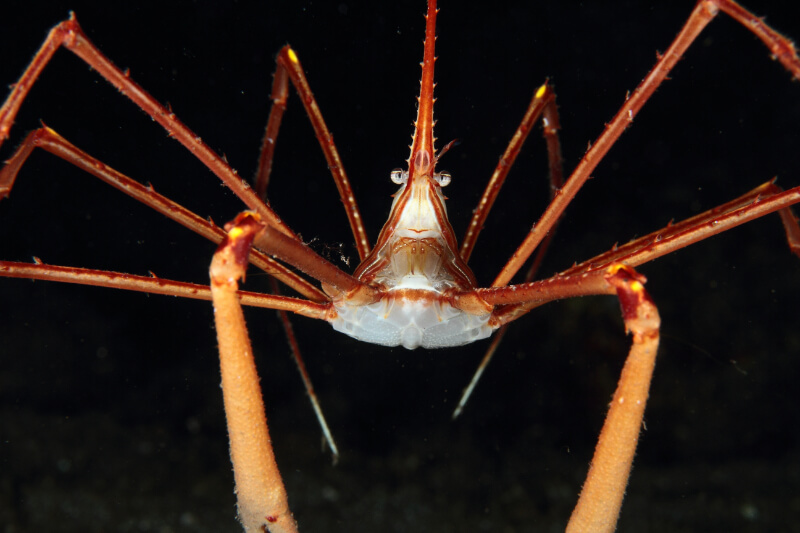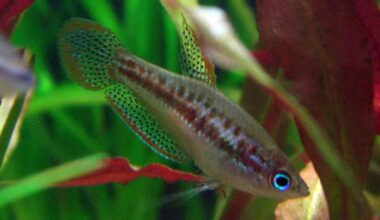
We hope you are ready to learn about an alien-looking crab! It is great to know the Arrow Crab is just a few inches in size and not several feet.
This crab is not too hard to care for although it is a bit aggressive so make sure to choose the proper tank mates.
The Arrow crab is among our favorites due to being in the intersection of cool and freaky so if you do not mind getting interesting looks from people seeing your tank, then this crustacean is perfect for you.
Let’s get started to guide you on how to properly care for your Arrowhead Crab!
Quick Facts 
| Scientific Name: | Stenorhynchus seticornis |
| Other Names: | Spider Crabs, Arrowhead Crabs, Yellowline Arrow |
| Reef Safe: | Yes with caution |
| Lifespan: | 5 years |
| Size: | 4 to 6 inches (carapace 1 to 2in and legs 4in) |
| Care: | Medium with proper water conditions |
| Diet: | Carnivore; shrimp, mollusks, flakes, pellets and invasive bristleworms |
| Water Parameters: | 72°F to 79°F, 8.1 to 8.4pH, 8 to 12dKH, 1.02 to 1.026SG |
| Tank Size: | 30 gallons |
| Behavior: | Aggressive |
| Breeding Difficulty: | High (limited number of eggs and delicate offsprings) |
Table of Contents
Species Summary
If you’re looking to add something unique and exciting to your tank, you can’t go wrong with an Arrow Crab. Also called Spider Crabs, Arrowhead Crabs and Yellowline Arrow Crabs, the Stenorhynchus seticornis is an ornamental species with fantastic cleaning habits.
They’re commonly found in the western Atlantic Ocean populating the lush coral reefs from around North Carolina down to Bermuda and Brazil. While most of these energetic scavengers stick to depths between 10 and 30 feet, some have been spotted lurking hundreds of feet down.
They’re most active during the night, ambling over sand, rocks, beds of seaweed and coral in their search for food. The daylight hours are spent hiding away from potential predators. Arrowhead Crabs are relatively inexpensive and can be successfully kept by both experts and beginners alike.
Author Note: Even with this crab’s easy care requirements, they’re not a perfect choice for every saltwater aquarium. Keep reading to learn more about their potential predatory behaviors as well as their exotic way of moving, stunning coloring and much more.
Appearance
Arrow Crabs almost look like underwater spiders with their tiny, triangular bodies and incredibly long legs. Some of these crabs have legs up to three times the length of their bodies. They also have a prominent serrated beak with eyes situated on either side of it. Eight of their 10 legs are used to walk while the last smaller two are pincers.
The color of the body can range from light cream or white to yellow or golden. The carapace is also often striped with lines of blue, black or brown. Their impressive legs are a crimson or yellow color while their claws are typically a darker blue or purple.
Lifespan
Arrow Crabs have a lifespan of about 5 years in captivity.
Average Size
The size of this crab’s carapace is often one or two inches long. The legs, on the other hand, can reach almost four inches. Generally, Arrowhead Crabs have an average size between four and six inches in length with some reaching an impressive 10 inches. Keep in mind that the females are typically much smaller than the males.
Arrow Crab Care
Arrowhead Crabs are naturally hardy and can thrive in a variety of saltwater habitats. You’ll have no problem keeping your crab healthy and strong as long as you maintain their water quality and provide an enriching environment.
Tank Size
You’ll need a medium to large size tank of at least 30 gallons for your Arrow Crab. It’s vital to give them enough space to carve out their own territory. Too small of an aquarium will increase the risk of aggressive clashes. Fortunately, larger tanks are often easier to maintain and are more likely to have delicious bristleworms your crab can eat.
What To Put In Their Tank
Give your crab plenty of shelter options by installing caves, ledges, rocks and overhangs. They tend to hunt in open areas, so be sure to have a large clear space of sandy substrate.
Author Note: You can even opt for crushed coral that can help you maintain a safe pH level. This type of substrate also continually releases calcium, which will make your crab’s molting process easier.
In the wild, Arrowhead Crabs seek safety in the long, beautiful strands of nearby anemones. You’re welcome to add a few to make your crab more comfortable and elevate your aquascaping.
Water Parameters
- Water temperature: 72°F to 79°F
- pH levels: 8.1 to 8.4
- Water hardness: 8 to 12 dKH
- Specific gravity: 1.02 to 1.026
Are Arrow Crabs Reef Safe?
Arrow Crabs are cautiously reef-safe as they tend to nip at soft corals and polyps. Your crab may also see other small crustaceans and shrimps as food. Consider keeping your fragile corals higher up and regularly monitor them for damage or stress. To eliminate any worry, you can instead decorate with sturdy, hard corals.
Food & Diet
Out in the reefs of the Atlantic Ocean, this crab will hunt amongst the rocks and corals for small fish, worms and invertebrates. To keep them satisfied in captivity make sure to feed your Arrowhead Crab with a varied diet of meaty bits like shrimp, mollusks, flakes, pellets and even invasive bristleworms. They’ll also scavenge up any food that falls to the substrate.
They’re not picky eaters, which makes it easy to keep them well-fed. Without enough food, they’re more likely to go after your corals as well as their tank mates.
Behavior & Temperament
These nocturnal crabs are fast movers that scuttle quickly around the tank while using their long arms to dig around in holes and crevices. They’ll typically stick in protected areas during the day before heading to exposed ledges to hunt once the sun sets. After adjusting to their new environment and feeding schedule, they can be prompted to come out more frequently.
Aggression
Arrowhead Crabs have semi-aggressive personalities that flare up around their own kind. Males especially can become very territorial and will fight others that come into their space. This aggression doesn’t fully develop until after they reach adulthood.
You may find your once-peaceful juvenile crab suddenly interested in chasing and fighting other crabs and small fish.
Molting
Like other crustaceans, your Arrow Crab will go through a process called molting in which they shed their shell once they grow too big (no, your crab is not dead). This is a natural, healthy process that usually only takes a few minutes.
Your crab will take weeks to prepare for their molting, but you may only notice changes in the last few days when they start moving slower. Once they shed their shell, they’re incredibly vulnerable and will need to hide out while they grow a new one.
Author Note: Rather than removing their old shell, you can leave it behind for them to consume for extra nutrients. Some experts recommend feeding crabs calcium supplements, but this isn’t necessarily a requirement if they’re on a well-rounded diet.

Arrow Crab Tank Mates & Predators
Due to their territorial instincts, it’s safest to have only one of these crabs in a tank at a time. Even if you have a large aquarium, your Arrowhead Crabs may still fight, and such scuffles could lead to injury or death. They do well in community tanks with peaceful medium or large fish.
Aggressive species like puffers, hawkfish and wrasses will have no problem making a meal of your crab. Arrow Crabs will also naturally view various aquatic worms, snails, invertebrates and even small, slow fish as their prey.
The best tank mates for your Arrowhead Crab include:
- Damselfish (try the Blue Devil Damselfish)
- Clownfish
- Tangs
- Basslets
- Cardinalfish
- Grammas like the Royal Gramma
- Angelfish (we like the Emperor Angelfish)
You may also have success with other crustaceans like Porcelain Crabs and Emerald Crabs. Make sure to monitor your Arrow Crab closely in the first week or two for any signs of stress, aggression or bullying.
Breeding
Currently, it is difficult bordering on impossible to breed these exciting crabs at home. The species’ unique spawning behaviors and gestation specifics can be hard to replicate in an aquarium, but they have successfully been reared in commercial settings.
Hobbyists looking to create a breeding pair will often buy one large and one small crab to increase their chances of picking a male and a female (see table below for more characteristics).
| How to identify Males | How to identify Females |
| Large claws | Smaller overall size |
| Triangular abdomens | Wider and rounder |
If your crabs accept each other, they may begin the courtship process immediately. In ideal conditions, they can breed and create fertilized eggs all year long.
After they mate the female will hold the clutch on her stomach for weeks until they can hatch. This process has a low success rate due to the limited number of eggs she can carry because:
- The sizes of both the female’s eggs and brood depend heavily on her size.
- As the eggs grow they limit the space on the female’s stomach even more.
To keep the crab larvae alive, you’ll need to place them in a safe rearing tank away from the female after they hatch. The offspring must be fed a nutrient-rich mixture around two times a day. They’re at the highest risk of mortality when they first begin eating. Providing inappropriate food that’s too big or without enough value can permanently harm them.
Author Note: Unfortunately, once these larvae undergo nutritional stress, they won’t be able to recover. Another possible deadly factor is your water quality and salinity. Even slight changes can lead to lasting damage that harms the larvae. You’ll have to complete frequent water tests and invest in a high-quality filtration system for the best results.
Wrapping Up
Now you are ready to add one or more Arrow Crabs to your aquarium!
This crab is a great option for tanks with Tangs and Clownfish since they can make great tank mates. Just make sure to keep your crab well fed to ensure your reef is safe from nipping.
We hope this guide answered all or most of your questions and if you still have a few things that remain unanswered please do not hesitate in reaching out to us.
If you have an Arrowhead Crab you are probably sharing some cool photos on social media so don’t forget to tag us on Facebook.
And if you are looking to learn about other saltwater fish take a look at our care guides. Good luck!

